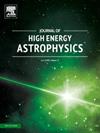Dark energy and cosmic evolution: A study in f(R,T) gravity
IF 10.5
4区 物理与天体物理
Q1 ASTRONOMY & ASTROPHYSICS
引用次数: 0
Abstract
In the context of gravity theory for the flat Friedmann-Lemaitre–Robertson–Walker (FLRW) model, the accelerating expansion of the universe is investigated using a specific form of the emergent Hubble parameter. Datasets from , Type Ia supernovae (SNIa), and Baryon Acoustic Oscillations (BAO) are used to constrain the model and identify the ideal parameter values in order to evaluate the statistical significance of gravity. The best-fit parameters are derived by solving the modified Friedmann equations through a MCMC analysis. These parameters are used to compute the equation of state, statefinders, energy conditions, and the plane. Furthermore, the evolution of kinematic cosmographic parameters is examined. The findings provide significant behavior and features of dark energy models. Our comprehension of the dynamics and evolution of the universe is improved by this study, which also advances our understanding of dark energy and how it shapes the universe. Also, a key outcome of our study is the demonstration that gravity can account for the Hubble tension through an evolving , in agreement with recent findings in modified gravity. Our results provide a significant contribution to the ongoing discussion of modified gravity models and their role in explaining cosmic acceleration, offering an alternative perspective to the standard ΛCDM paradigm.
暗能量与宇宙演化:f(R,T)引力的研究
在平面弗里德曼-勒梅特-罗伯逊-沃克(FLRW)模型的f(R,T)引力理论背景下,利用涌现哈勃参数的特定形式研究了宇宙的加速膨胀。利用H(z), Ia型超新星(SNIa)和重子声学振荡(BAO)的数据集来约束模型并确定理想参数值,以评估f(R,T)引力的统计显著性。通过MCMC分析,求解修正的Friedmann方程,得到最佳拟合参数。这些参数用于计算状态方程、状态查找器、能量条件和(ω−ω’)平面。此外,还研究了运动宇宙学参数的演化。这些发现提供了暗能量模型的重要行为和特征。这项研究提高了我们对宇宙动力学和演化的理解,也促进了我们对暗能量及其如何塑造宇宙的理解。此外,我们研究的一个关键结果是证明f(R,T)引力可以通过演化的H0来解释哈勃张力,这与最近在修正引力中的发现一致。我们的结果为正在进行的关于修正引力模型及其在解释宇宙加速中的作用的讨论提供了重大贡献,为标准ΛCDM范式提供了另一种视角。
本文章由计算机程序翻译,如有差异,请以英文原文为准。
求助全文
约1分钟内获得全文
求助全文
来源期刊

Journal of High Energy Astrophysics
Earth and Planetary Sciences-Space and Planetary Science
CiteScore
9.70
自引率
5.30%
发文量
38
审稿时长
65 days
期刊介绍:
The journal welcomes manuscripts on theoretical models, simulations, and observations of highly energetic astrophysical objects both in our Galaxy and beyond. Among those, black holes at all scales, neutron stars, pulsars and their nebula, binaries, novae and supernovae, their remnants, active galaxies, and clusters are just a few examples. The journal will consider research across the whole electromagnetic spectrum, as well as research using various messengers, such as gravitational waves or neutrinos. Effects of high-energy phenomena on cosmology and star-formation, results from dedicated surveys expanding the knowledge of extreme environments, and astrophysical implications of dark matter are also welcomed topics.
 求助内容:
求助内容: 应助结果提醒方式:
应助结果提醒方式:


